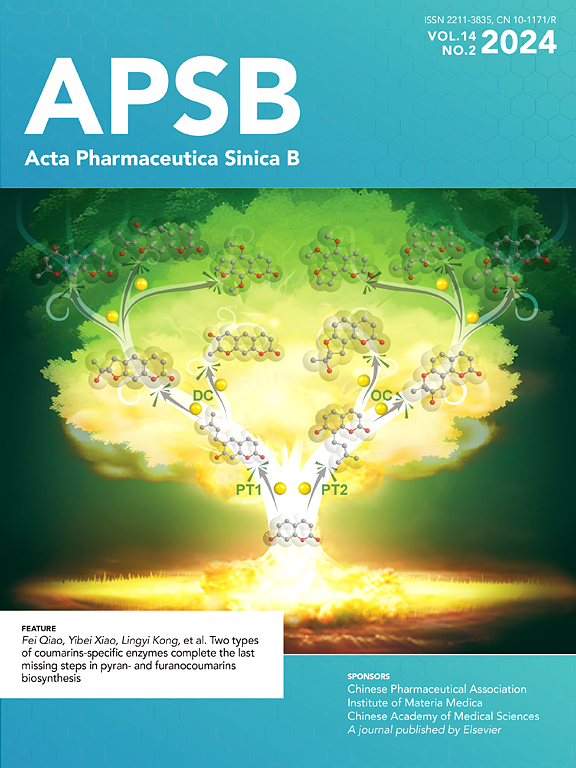Discovery of Yersinia LcrV as a novel biased agonist of formyl peptide receptor 1 to bi-directionally modulate intracellular kinases in triple-negative breast cancer
IF 14.6
1区 医学
Q1 PHARMACOLOGY & PHARMACY
引用次数: 0
Abstract
G protein-coupled receptors (GPCRs) are significant drug targets, but their potential in cancer therapy remains underexplored. Conventional GPCR agonists or antagonists have shown limited effectiveness in cancer treatment, necessitating new GPCR-targeting strategies for more effective therapies. This study discovers that Yersinia pestis LcrV, a crucial linker protein for plague infection, acts as a biased agonist of a GPCR, the formyl peptide receptor 1 (FPR1). The LcrV protein induces unique conformational changes in FPR1, resulting in G proteins being activated in a distinctive state without subunit dissociation. This leads to a biased signaling profile characterized by cyclic adenosine monophosphate (cAMP) responses and β-arrestin2 recruitment, but not calcium mobilization. In FPR1-expressing triple-negative breast cancer (TNBC) cells, LcrV bi-directionally modulates intracellular signaling pathways, downregulating extracellular signal-regulated kinases (ERK1/2) and Akt pathways while upregulating Jun N-terminal kinase (JNK) and p38 pathways. This dual modulation results in cell cycle arrest and the inhibition of TNBC cell proliferation. In TNBC xenograft mouse models, long-term LcrV treatment inhibits tumor growth more effectively than a conventional FPR1 antagonist. Additionally, LcrV treatment reprograms tumor cells by reducing stemness-associated proteins OCT4 and c-MYC. Our findings highlight the potential of biased GPCR agonists as a novel GPCR-targeting strategy for cancer treatment.

发现耶尔森菌LcrV作为甲酰基肽受体1的新型偏倚激动剂双向调节三阴性乳腺癌细胞内激酶
G蛋白偶联受体(gpcr)是重要的药物靶点,但其在癌症治疗中的潜力仍未被充分发掘。传统的GPCR激动剂或拮抗剂在癌症治疗中显示出有限的效果,需要新的GPCR靶向策略来实现更有效的治疗。这项研究发现鼠疫耶尔森菌LcrV是鼠疫感染的一个关键连接蛋白,可作为GPCR甲酰基肽受体1 (FPR1)的偏倚激动剂。LcrV蛋白在FPR1中诱导独特的构象变化,导致G蛋白在没有亚基解离的特殊状态下被激活。这导致以环磷酸腺苷(cAMP)反应和β-arrestin2募集为特征的偏倚信号传导谱,而不是钙动员。在表达fpr1的三阴性乳腺癌(TNBC)细胞中,LcrV双向调节细胞内信号通路,下调细胞外信号调节激酶(ERK1/2)和Akt通路,上调Jun n -末端激酶(JNK)和p38通路。这种双重调节导致细胞周期阻滞和抑制TNBC细胞增殖。在TNBC异种移植小鼠模型中,长期LcrV治疗比传统的FPR1拮抗剂更有效地抑制肿瘤生长。此外,LcrV治疗通过降低干细胞相关蛋白OCT4和c-MYC对肿瘤细胞进行重编程。我们的研究结果强调了偏倚GPCR激动剂作为一种新的GPCR靶向癌症治疗策略的潜力。
本文章由计算机程序翻译,如有差异,请以英文原文为准。
求助全文
约1分钟内获得全文
求助全文
来源期刊

Acta Pharmaceutica Sinica. B
Pharmacology, Toxicology and Pharmaceutics-General Pharmacology, Toxicology and Pharmaceutics
CiteScore
22.40
自引率
5.50%
发文量
1051
审稿时长
19 weeks
期刊介绍:
The Journal of the Institute of Materia Medica, Chinese Academy of Medical Sciences, and the Chinese Pharmaceutical Association oversees the peer review process for Acta Pharmaceutica Sinica. B (APSB).
Published monthly in English, APSB is dedicated to disseminating significant original research articles, rapid communications, and high-quality reviews that highlight recent advances across various pharmaceutical sciences domains. These encompass pharmacology, pharmaceutics, medicinal chemistry, natural products, pharmacognosy, pharmaceutical analysis, and pharmacokinetics.
A part of the Acta Pharmaceutica Sinica series, established in 1953 and indexed in prominent databases like Chemical Abstracts, Index Medicus, SciFinder Scholar, Biological Abstracts, International Pharmaceutical Abstracts, Cambridge Scientific Abstracts, and Current Bibliography on Science and Technology, APSB is sponsored by the Institute of Materia Medica, Chinese Academy of Medical Sciences, and the Chinese Pharmaceutical Association. Its production and hosting are facilitated by Elsevier B.V. This collaborative effort ensures APSB's commitment to delivering valuable contributions to the pharmaceutical sciences community.
 求助内容:
求助内容: 应助结果提醒方式:
应助结果提醒方式:


